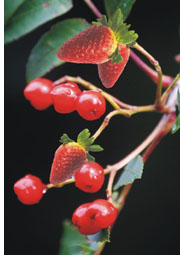Plant Patent
and Plant Breeder's Rights
A plant patent and plant breeder's rights are unique intellectual property rights.
The requirement to get a patent for a plant is essentially the same as for any other invention, namely it must be distinctly new.

It is a further requirement that the plant can be asexually reproduced.
This means reproduction by means other than seeds such as grafting, budding, layering or the rooting of cuttings.
A plant patent cannot be obtained for tuber-propagated plants.
If you've found a new plant variety by discovering it in nature, you cannot obtain a patent for it, unless you can asexually reproduce it and prove the variety is stable, uniform and "new".
A patent grants the plant breeder the exclusive right to gain financially from the new variety. It can be by producing and selling the plant, selling the rights to breeding the plant or by receiving royalties from sales made by someone else.
Note: Once someone has duly bought a plant, no royalties are payable on the crop it may produce.
They can also use the seed for growing another crop without further payment of royalties.
The lifespan of a plant patent is about 20 years and applications are made through your country's Patent Office.
You are here:




